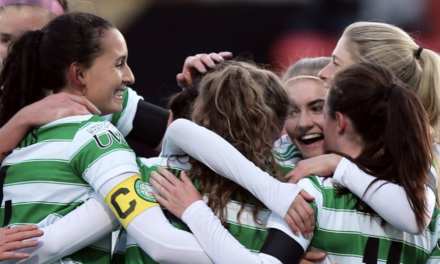Time for the good, the bad, & the ugly from yesterday’s Celtic vs AC Milan game. Non-penalty xG was 0.67 vs 0.77 per Wyscout, and I have seen other models had both teams around 1.00- needless to say there was not a big difference in total chance creation. The quality of each chance showed a greater disparity, with Milan putting 3 of 4 shots on goal, with all 3 central and inside the box. Milan’s other shot was blocked off a free kick. In contrast, Celtic put 2 of 12 shots on goal, with Ntcham’s 5th minute effort and Moi’s goal both decent chance quality. Average xG per shot of 0.20-0.25 reflects high quality chances an average for Celtic of less than 0.10.
From a defending and keeper perspective, the game had some similarities with the 3-1 loss to Copenhagen last season. Copenhagen also scored on all 3 shots they put on goal (of 7 total), with post-shot xG of 1.07 vs Barkas compared with 1.29 vs Forster.
Good goes to the last 30 minutes of the game, as Celtic began to control the midfield, increase tempo, and possession. About 2/3rds of Celtic’s xG and 5 of 12 shots came in that time, while Milan’s only attempt was the 3rd goal in extra time. Here is a graph of possession:
I am no fan boy of possession for the sake of possession, but the timing of chance creation increasing having coincided with increased possession is notable in this instance, IMO, as it suggests substitutions around 65th minute played a large part in the improved performance level compared with the halftime subs and/or change in shape. The substitutions were likely important for both sides, as Kessie came off for Milan a couple of minutes after Brown was subbed.
The other good and my MOTM goes to Laxalt. He won 22 of 32 duels in a game where Celtic lost almost 55% of duels overall. He won 9 of 14 defensive duels vs just 49% for the team. He was also successful on 5 of 7 dribbles, had 7 progressive runs, 7 progressive passes, and 1 key pass. His main “blemish” was 0-5 on crosses.
Bad goes to the relative deficit in athleticism for Celtic compared to Milan, which the relatively low duel win rate was just one symptom. Despite possession being close overall at about 49%-51%, Milan had 56 interceptions vs 36 for Celtic. Celtic won just 49% of defensive duels vs typical rate
above 60%. There appears to be consensus that Celtic’s effort was higher vs Milan relative to the derby Saturday, but Celtic won 63% of defensive duels in the derby and had 48 vs 56 interceptions. Milan’s starting midfield three won 27 of 53 duels vs 19 of 50 for Celtic.
Ugly goes to the continued excuse making and defense of incoherent decision making. I spent 2 hours speaking with Harry Brady back in July about how grossly negligent it would be for Brown to be a centerpiece at a European level this season. Here is an updated chart of possession adjusted defensive duels won + slide tackles won + interceptions per 90 minutes in SPFL league games only for Brown and comparing with Gary Dicker since 2015-2016 season. They are broken out by aged seasons, and Brown is a year older than Dicker.
Why compare Brown with Dicker? Beyond the fact that they are of a similar age playing in the same league, the comparison shows how much better Brown was after he made lifestyle changes under Rodgers. However, it also shows how far his production has dropped off and that he is now a lot closer to Dicker than a last 32 Europa League or Champions League group stage level midfielder. The possession adjustment is done to normalize defensive output assuming 50% possession for each team. This reduces the defensive opportunities for a player like Dicker and increases for a player like Brown, as Kilmarnock have averaged less than 50% and Celtic greater than.
In the Milan game specifically, Brown won 4 of just 9 duels overall and 3 of 5 defensive duels vs Milan, intercepted 7 times and had 0 slide tackles. He only received 21 passes over 63 minutes. With no ball progression output or any creativity, what is left? This is not an “attack” on Brown- I have no doubt he is giving 100%. It is his usage by the manager which has been, and remains, the shining example of poor judgment.
Add to this glaring issue the other questionable selection and tactical decisions, and the league challenge from Rangers in a 10-in-a-row season requires better judgement. Klimala was supposedly not fit enough to play versus Ferencvaros, but Griffiths and Ajeti were versus Milan? Moving to a two-striker system but then playing midfielders regularly as one of the two strikers? Playing a 6th choice 20-year-old CB making his 3rd appearance to preserve a 3-5-2 shape versus a team the quality of Milan? The list is long and difficult to reconcile.
Fitness and Covid issues have simply amplified the importance of sound decisions. The manager showed signs of relenting his stubbornness late in the Kilmarnock draw but quickly reverted to type. Hopefully the last 30 minutes versus Milan serve as a wakeup call and he is able to make desperately needed changes. It is not too late to correct course.







